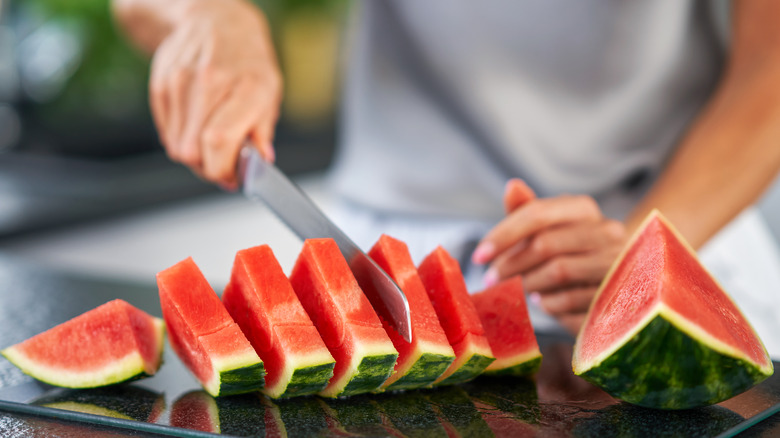Why You Should Be Using A Bread Knife To Cut Fruit
We may receive a commission on purchases made from links.
Walk into any first-year culinary school classroom and chances are you'll see everyone chopping up piles of vegetables as they learn all the basic knife cuts that they'll need to become chefs. Knife skills are super important to master if you're serious about cooking, for a couple of reasons.
First, and most importantly, learning to handle kitchen knives will prevent you from cutting yourself. You'll probably still cut yourself every now and then because accidents happen, but you'll learn to safely handle your knifes like the tools that they are, instead of making common mistakes that can cost you a fingertip. Second, knife skills ensure that everything you cut is the same size, which is imperative when you're cooking; you don't want some pieces of potato overcooked and some undercooked, for example, because that's how you get lumpy mashed potatoes.
There are lots of shapes and sizes of kitchen knives, which can be a little intimidating when you're trying to choose the right tools for your kitchen. You really only need a few basics, however, and besides a good-quality chef's knife and paring knife, your best friend in any kitchen is a serrated bread knife. Even if you don't cut a lot of fresh baked loaves of bread, serrated knives are perfect for cutting other unwieldy items, especially large pieces of produce like melons and winter squash.
Serrated bread knives are a super slicer
Serrated knives are essential in any kitchen if you bake bread, because they are designed to make perfect fluffy slices by cutting with a back-and-forth sawing motion. They are thinner and longer than chef's knives, with pointy teeth that can cut through crunchy crusts but then slide through delicate bread crumb without needing to press down and squish the loaf.
While serrated knives aren't good for jobs like dicing onions or mincing herbs, they're perfect for cutting and slicing anything else that's got a tough exterior and a soft center like bread. They're also great for handling soft, delicate produce like tomatoes, and can handle tough exteriors like pineapple husks. And just like with cutting bread, when you slice produce with that back-and-forth motion with your serrated knife, the slender blade won't squish the tender exterior of your fruit or veggies, and you won't end up losing any of the precious juice inside.
If you want to make quick work of a big, bulky piece of fruit like a honeydew or a butternut squash, always reach for your serrated knife. A serrated blade gives you much more control than a straight blade when you're cutting up something big. Its teeth will dig into the flesh of the rind without slipping all over the place, like a dull chef's knife might. Plus the knife's long length will reach all the way across a whole watermelon, so you can make single, clean cuts.
Serrated knife basics
Chef's knives get all the glory when it comes to choosing blades, and a high-quality model can be quite expensive, but a decent serrated knife does not need to break the bank. Just like any kitchen tool, you can spend hundreds of dollars on a fancy bread knife, but most line cooks and chefs are happy to use a serrated knife that costs less than $100.
If you're not going to be cooking professionally, you can even go with something that's $50 or less. Think of it as the reciprocating saw of the kitchen — it doesn't have to be fancy to get the job done.
You also don't need to be as fastidious at keeping your serrated knife sharp as you do with your chef's knife. According to MasterClass, you don't need to sharpen it as often because it doesn't make contact with a cutting board as frequently as other knives. The best test to know if your knife needs to be sharpened is to cut a piece of bread from a loaf; if you create lots of crumbs, it's time to give the bevels a little love with a sharpening rod.


